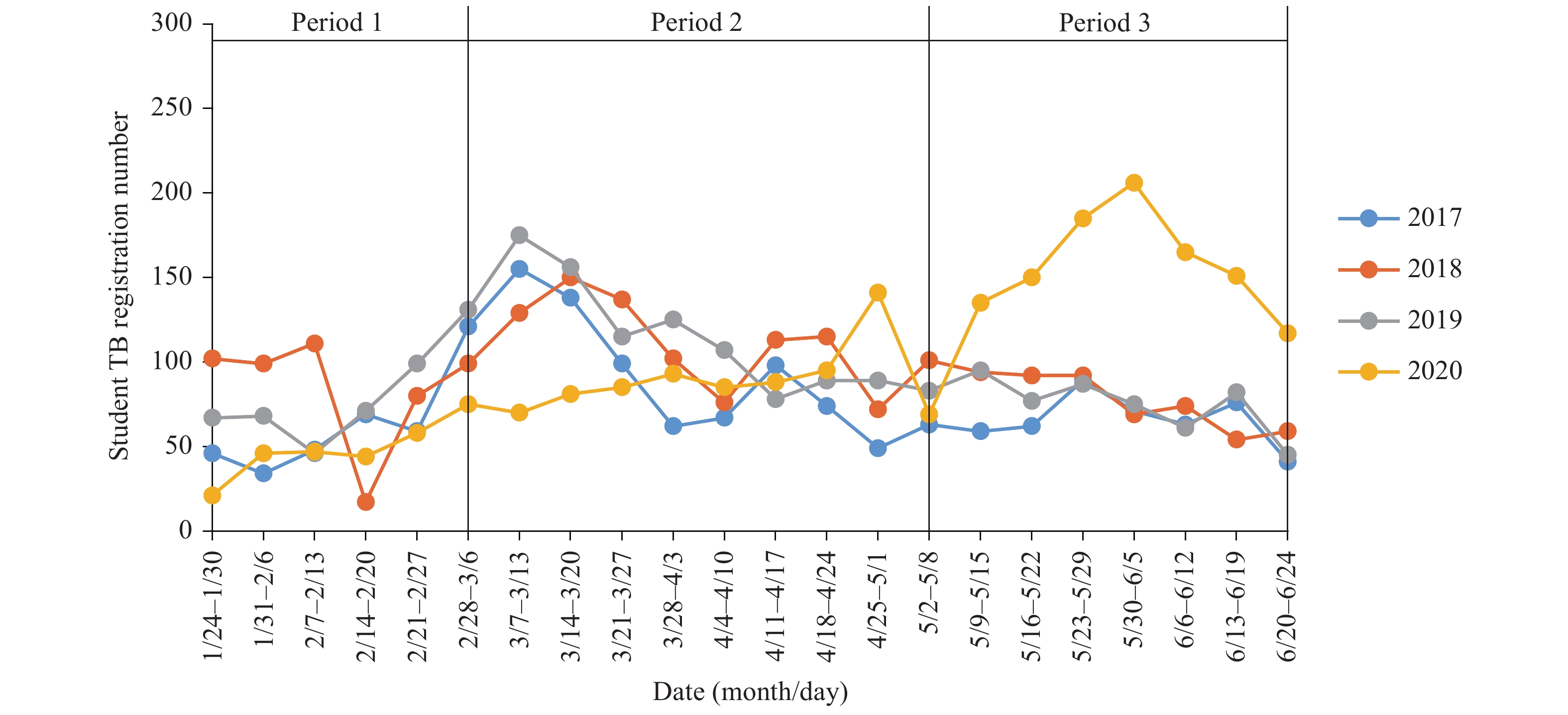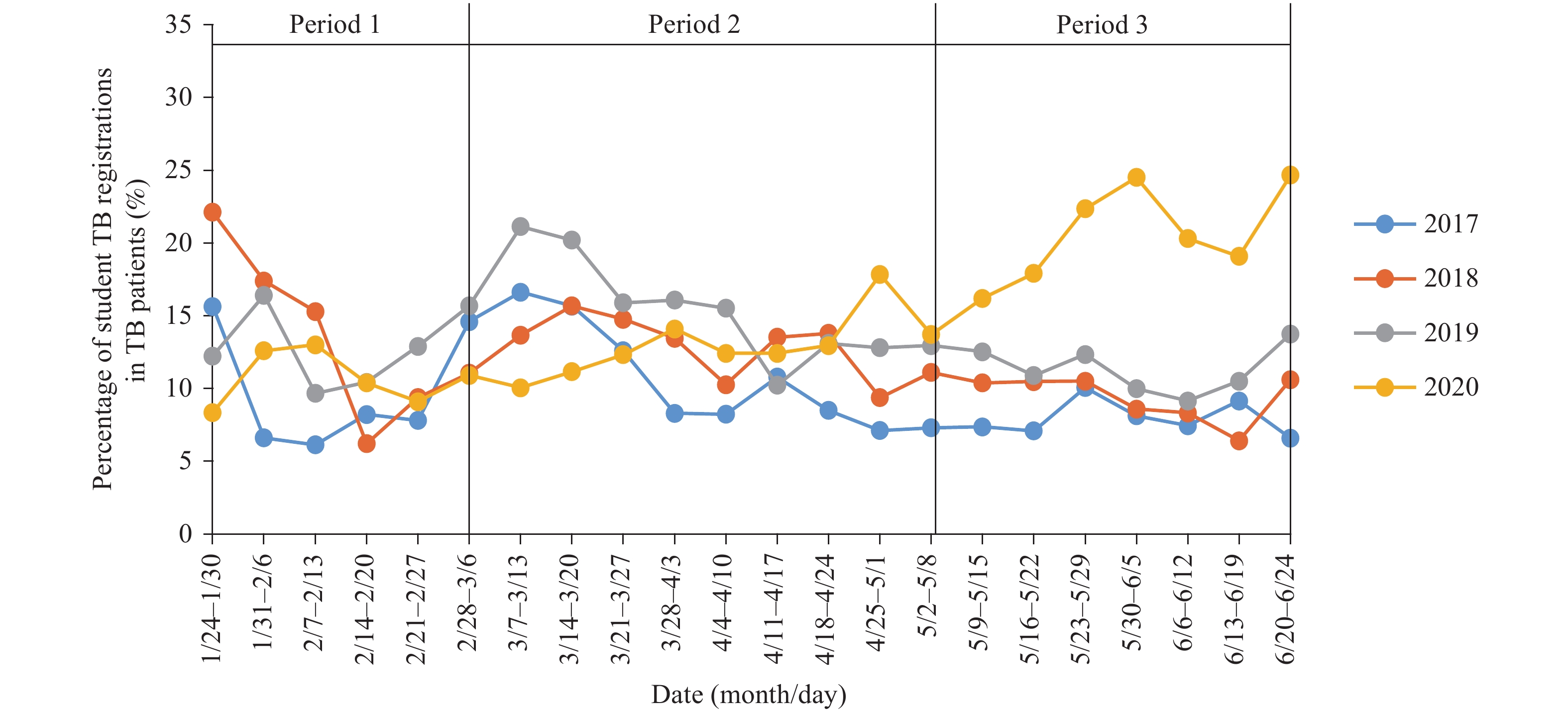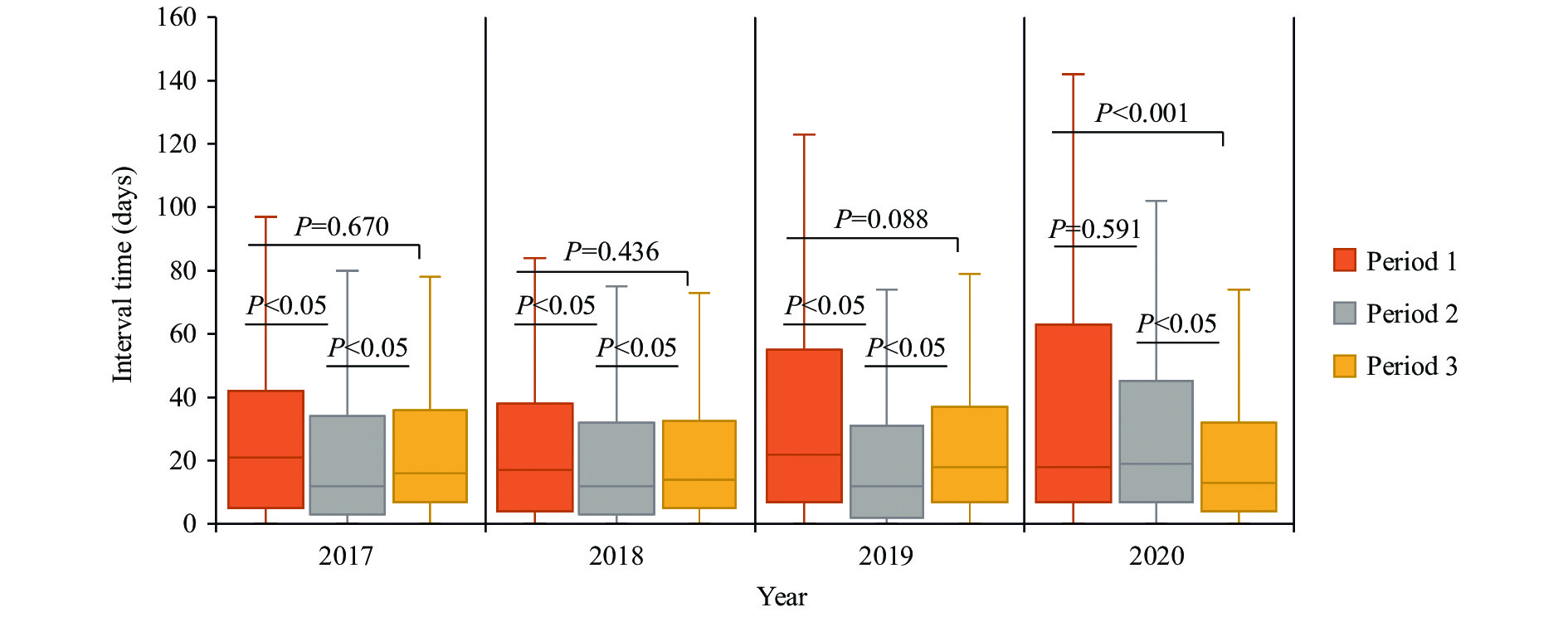-
During the COVID-19 epidemic in 2020, district blockages, community and traffic restrictions, and public recreation and school closure (1-2) all caused delays in tuberculosis (TB) diagnoses, reducing the registered number of TB cases and possibly resulting in additional deaths. This was due to a decrease in detection of TB patients (3-5), which might have the same effect on TB among students. Students are one of the key groups for TB prevention and control in China (6). Due to COVID-19, students stayed at home for nearly four months for winter vacation. The Guizhou Provincial Health Commission required students with a cough and expectoration to go to a TB-designated hospital for chest radiography to rule out TB before returning to school. The data was collected from the TB Information Management System (TBIMS) of China. The 2020 data used for analysis was collected between January 24 and June 24, as this was the time when the COVID-19 response was implemented in Guizhou. We divided the response into three periods based on three key time points. The 2017–2019 data from the same time frame as that of 2020 were used for comparison. They were also divided into three corresponding periods. Analysis showed that the registered student TB rates in 2020 decreased in the first and second periods, but increased in the third period compared to 2017–2019, whereas the total registered TB cases in Guizhou decreased. In 2020, the time interval between symptom onset and care-seeking of the TB among students in third period was shorter than the interval in the first period and the second period. This study showed that carrying out active screening for students is an important strategy for early detection of TB patients, which could offset the negative impacts of COVID-19 on TB detection and prevent TB outbreaks in schools.
Data in this analysis was from the TBIMS of China, from which data of student TB patients registered in Guizhou Province was derived from 2017 to 2020. We divided the COVID-19 response in Guizhou into three periods based on three key time points: the first period was from January 24 to February 27, 2020, when Guizhou started the highest level COVID-19 response, namely the COVID-19 pandemic period; the second period was from February 28 to May 1, 2020, when people resumed work, namely the work resumption period; and the third period was from May 2 to June 24, 2020, when students went back to school and had their physical check-up for college entrance examination, namely the back-to-school, as well as intensive physical check-up period. We divided 2017–2019 into the same periods, the three years prior to the COVID-19 epidemic. In 2017–2019, the return to school and college entrance examination physical check-up took place in the second period (March to May) rather than in the third period. The number of registered TB patients in the whole population and among students was counted in weeks, and SPSS (version 26.0, IBM Corp., Armonk, NY) was used for statistical analysis. Countable variables were presented by number of cases and percentage. Chi-squared tests were used for categorical data, and Kruskal-Wallis tests were used for continual data. P<0.05 was considered statistically significant.
In 2020, the numbers of registered TB patients in Guizhou Province in the three periods were 2,017 cases, 6,370 cases, and 5,917 cases, respectively, a decrease of 31.67%, 12.58%, and 4.39% compared with the mean registered cases in the same periods in 2017–2019.
In 2020, the number of registered TB patients among students in the three periods was 216 cases, 813 cases, and 1,178 cases, respectively (Figure 1). While compared with the mean cases of the previous 3 years, it was found that in 2020 the number decreased by 36.22% and 16.50% in the first and second periods, respectively, but increased by 100.34% in the third period. In 2020 and the previous 3 years, the student TB cases who were found during the period of back-to-school and intensive physical check-up for entrance examination of college accounted for 19.91% (1,178/5,917) and 13.37% (974/7,287) of the total registered TB cases respectively, and the difference was statistically significant (P<0.05)( Figure 2).
 Figure 1.
Figure 1.The registration number of tuberculosis (TB) among students in 3 periods, Guizhou Province, 2017–2020.
 Figure 2.
Figure 2.The proportion of student patients among total tuberculosis (TB) cases in 3 periods, Guizhou Province, 2017–2020.
The median of the interquartile range (IQR) of time interval between symptom onset and care-seeking of the student TB patients in 2020 was 18 (7–63) days in the first period, 19 (7–45) days in the second period, and 13 (3–32) days in the third period. The difference between the first two and the third periods was statistically significant (P<0.05). Similarly, in 2017–2019, the median of the IQR of time interval between symptom onset and care-seeking in the second period (back-to-school and intensive physical check-up) was shorter than the other two periods. The difference was also statistically significant (P<0.05) (Figure 3).
 Figure 3.
Figure 3.The comparison interval time between first symptom onset and first seeking medical care/physical check-up of student tuberculosis patients in the 3 periods in 2017–2020.
Note: Boxplot was used for describing the distribution of interval along y axis, the line inside the box was median. P value: Kruskal-Wallis Test, P value <0.05 was considered significant. -
In the first period of the COVID-19 epidemic, the registration number of TB patients (including student patients) in Guizhou dropped by a third compared with the mean number of the previous 3 years in the same period, which is consistent with reports from China and other countries (1,3-4). The reported TB incidence among students in China peaked from March to April each year, which could be explained by the intensive physical check-up for the entrance examination of college (6). This is inconsistent with the peak of student TB registration in Guizhou Province in 2017–2019. Due to the impact of the COVID-19 pandemic, the intensive physical check-up in the second period (February 28 to May 1) in 2017–2019 was postponed to the third period (from May 2 to June 24) in 2020, leading to a shift of the peak of student TB registration. Since Guizhou is a province with a high burden of TB, long exposure in the family is also one of the risk factors that increases TB (7). Therefore, it is required that students in Guizhou with symptoms of coughing and expectoration are evaluated for TB with a chest radiograph at a designated TB hospital before resuming school. The implementation of the new screening measure in 2020 detected more TB patients, resulting in a significantly higher registration number of student TB in the back-to-school and physical check-up for entrance examination period (May 2 to June 24) than in the first and second period. The pattern was also observed in the back-to-school and intensive physical check-up period (February 28 to May 1) in 2017–2019.
In both 2020 and 2017–2019, the time interval between the onset of symptoms and seeking medical care of student TB patients was similar. The interval in the intensive physical check-up period was shorter than that in other periods, which indicated that active screening plays a positive role in early detection of TB patients. Since most student TB patients were detected through physical check-up and most have no symptoms before diagnosis (8), it can be assumed that the students who were infected with Mycobacterium tuberculosis before and during the COVID-19 epidemic but had no symptoms would not have been found out if they had not got the physical check-up. It was also assumed that if there were no implementations of the new policy of active screening, those who had symptoms but did not go to the doctor would not have been diagnosed in a timely manner. Therefore, whether the COVID-19 epidemic affects the time interval for student TB is still uncertain.
A limitation of this study was that although more students with tuberculosis were found through active screening, we did not have information on suspected TB symptoms and chest radiograph results of these cases. We were unable to do further analysis on the effectiveness of the active screening strategy on finding asymptomatic patients or patients with varying degrees of abnormal pulmonary changes indicated by chest radiography.
In conclusion, this study suggests that after students leave campus and stay at home for a long time, using chest radiography to screen those with suspicious symptoms before resuming school can be an effective measure for the early detection, early diagnosis, and early treatment of student TB patients. It can also be an important intervention for reducing TB outbreak in schools.
-
Dr. Zhijun Li of US CDC China Office.
HTML
| Citation: |



 Download:
Download:




